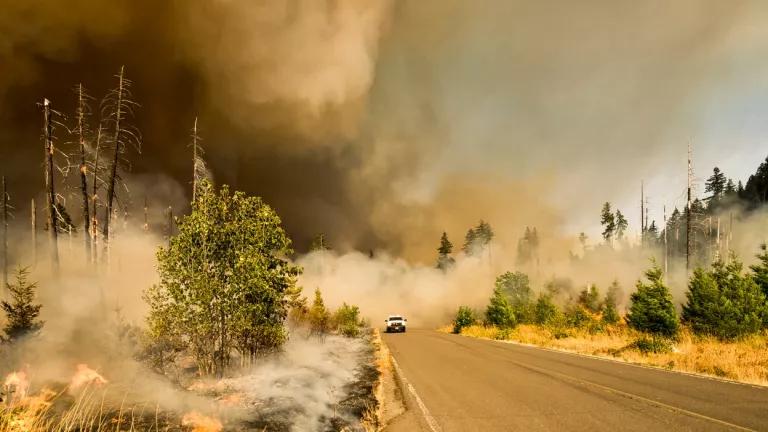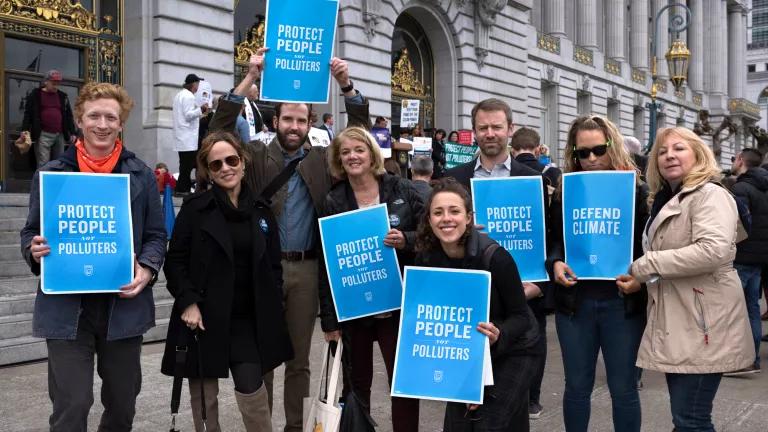Shattering Records, Climate Disasters Fueled Misery in 2020

As the costs of 2020's unyielding march of climate disasters come into view, action on this crisis is more urgent than ever.
According to new data just released by the National Oceanic and Atmospheric Administration (NOAA), 2020 set a new peak for the number of billion-dollar climate and weather disasters across the country since 1980 when its cost reporting began. All told, the United States suffered from 22 billion-dollar disaster events—shattering the previous annual record of 16 events that occurred in each of two prior years (2011 and 2017). NOAA has been tracking these especially costly disasters for four decades, and its latest report is a wake-up call that the costs of climate change are not some distant threat; they’re here and now.
2020 is also making headlines for tying with 2016 as the hottest on record and being the globe’s 44th year in a row with above-average temperatures. All that extra heat in our climate system is supercharging many of the climate and weather disasters tracked by NOAA—including wildfires, drought, and coastal storms. Last year, these climate-fueled events harmed Americans from coast to coast and killed 262 people, by NOAA’s estimate:

NOAA’s billion dollar event cost estimates are based on the agency’s estimates of damages inflicted to property, crops, and infrastructure. All told, the latest NOAA report points to $95 billion in damages from last year’s 22 billion-dollar disaster events. According to another new analysis by Munich Re, the expense of U.S. disaster events during 2020 accounted for 45% of the losses worldwide.
A Disastrous Toll on Human Health
It will take years for the true toll of last year’s climate and weather disasters to become more apparent. It’s been difficult to track the financial impacts of the health problems linked to climate change, in part due to poor public health data systems that do not enable rapid understanding of climate-related health problems and the costs of treating these medical issues in hospitals and emergency rooms. A further obstacle to more complete damage estimates is the fact that data collection is the responsibility of badly underfunded public health departments. In addition to their health monitoring work, these agencies are also working on shoestring budgets to plan for and respond to these events that are growing in geographic scope and severity year after year.
Unfortunately NOAA’s gigantic damage estimate only represents only a fraction of the true toll of these events, which harmed human health in severe ways:
- Western wildfires (NOAA damage estimate: $16.5 billion): the historic fires burned more than 10 million acres across California, Oregon, and Washington and generated huge plumes of deadly smoke, impairing air quality for millions of people, and the fires caused at least 46 direct deaths.
- Hurricane Laura (NOAA damage estimate: $19 billion): Hurricane Laura hit southwestern Louisiana with a storm surge of more than 15 feet and killed 42 people, according to NOAA. It was one of the year’s record number of 12 named storms that made landfall in the United States.
- Heat and Drought (NOAA damage estimate: $4.5 billion): Widespread drought and severe heat waves afflicted more than a dozen western and central states for much of last year. The heat broke a slew of records across the region, including in Los Angeles, California, which recorded a record high of 121° F on September 6. NOAA estimates that 45 deaths were linked to extreme temperatures, though heat-related health impacts are generally underestimated.
Because the serious damages to human health caused by climate and weather disaster events are not included in the NOAA price tag, the true costs inflicted by these events are likely much higher. But by how much? We recently investigated the health costs of climate-sensitive events in the U.S. over one year. That research, analyzing just a sample of climate-fueled disasters from coast to coast (including wildfires, extreme heat, air pollution, and a major hurricane), identified more than 900 deaths, 20,000 hospitalizations, 17,000 emergency room visits, and 37,000 outpatient encounters (outpatient visits, home health care visits, and instances in which medications were prescribed). The total bill for those damages to human health? $10 billion. Even that total is likely an underestimate due to data gaps that inhibit a more expansive tallying the human toll of climate-fueled disasters.
Many communities across the country faced an onslaught of multiple climate-related threats throughout the year, and the health costs of 2020’s deadly disasters compounded the physical, mental, and financial burden placed on individuals, families, and communities struggling to respond to the COVID-19 pandemic.
Reducing Harm in the Years Ahead
The science is clear: these dangerous effects of climate change will worsen each year that we fail to curb the pollution that is destabilizing our planet. The evidence is here: 2020 was also marked by wildfires that burned unprecedented swaths of tinder-dry land in California and a record number of tropical storms. Beyond the United States, other countries suffered tremendous disaster damages in 2020, including $17 billion in damages linked to summer flooding in China and $14 billion from Cyclone Amphan impacts in Bangladesh and India.
As the climate crisis accelerates, it’s crucial that we step up to address the root of the problem and cut carbon pollution. At the same time, we’ve got to better prepare communities for climate impacts to avoid irreversible damage to public health. Doing so will help to prevent profound suffering and, as our work shows, save Americans billions of dollars in health costs each year. As 2021 begins, a strong response to climate change is urgent and inaction is unaffordable.



